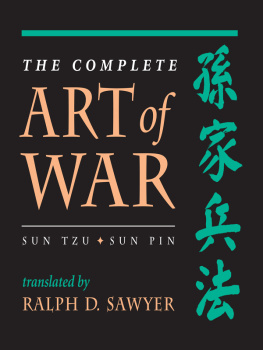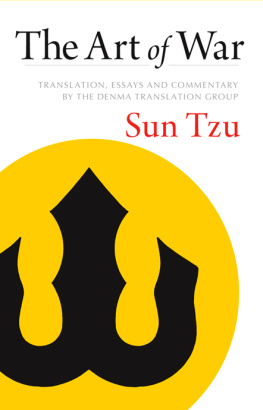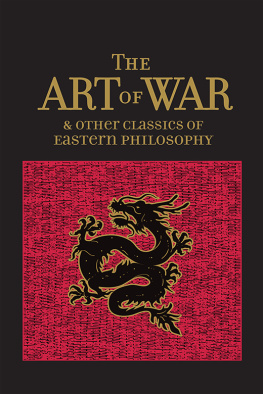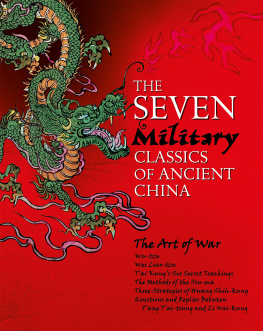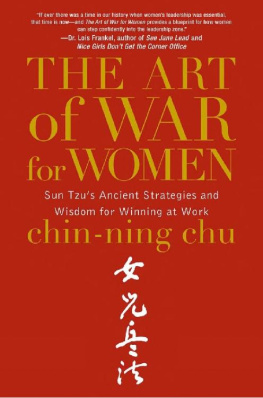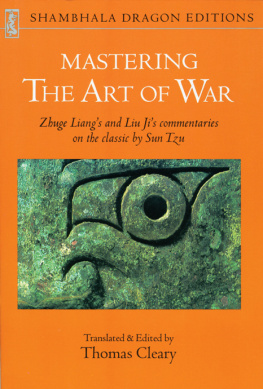All rights reserved. Printed in the United States of America. No part of this publication may be reproduced or transmitted in any form or by any means, electronic or mechanical, including photocopy, recording, or any information storage and retrieval system, without permission in writing from the publisher.
Copyright 1996 by Ralph D. Sawyer
Published in 1996 in the United States of America by Westview Press, Inc., 5500 Central Avenue, Boulder, Colorado 80301-2877, and in the United Kingdom by Westview Press, 12 Hids Copse Road, Cumnor Hill, Oxford OX2 9JJ
A CIP catalog record for this book is available from the Library of Congress.
ISBN 0-8133-3085-8
eBook ISBN: 9780465003877
The paper used in this publication meets the requirements of the American National Standard for Permanence of Paper for Printed Library Materials Z39.48-1984.
Preface
One who knows the Tao of the Sun family will invariably unite withHeaven and Earth.
The concepts and principles embodied in Sun-tzus long-famous Art of War not only determined the thrust of Chinese military science for two and a half millennia but also remain important even today, being found in many spheres and diverse applications. Moreover, the implications of this laconic textand now Sun Pins Military Methods as wellare constrained solely by the readers perspective and imagination. Among the many interpretations presently seen in the Far East and, to a more limited extent, Western countries as well, perhaps the most fruitful derive their utility from mapping military thought onto analogous domains. Naturally the concepts and tactics provide important material for military science in general, and many have been incorporated into contemporary doctrine by armies worldwide, including the U.S. Marine Corps. The business world and especially marketing, long considered battlefields and characterized in terms of military idioms and tactics, provide the most conducive, frequently explored environments. However, in Asian countries it has become popular to adopt abstracted tactics and conceptual principles from the Sun family military writings to personal life, ranging from the simplest social activities through career advancement and interactions with society at large. Some books even apply fundamental perceptions to the stock market, sexual relationships, and self-defense, largely through stimulating an awareness in the reader that other perspectives and unorthodox tactical principles might be applied in so-called ordinary situations.
The intent of The Complete Art of War is to provide readers with an integrated edition of the remarkable Sun family military writingsSun-tzus famous analytic overview of the nature of warfare known as the Art of War and the work recently recovered from a Han dynasty tomb attributed to his direct descendant Sun Pin, also entitled the Art of War but, for convenience, best identified as Military Methods. This integrated edition differs from our previous single-volume editions (and the Art of War translation included in our SevenMilitary Classics translation) in unifying and expanding the chapter commentaries; appending a tactical index; revising the translations slightly to make them more accessible upon first reading; excising material of interest primarily to scholars; abridging the historical background; and deleting the tactical analysis of the various battles.
While the Sun family military writings remain eminently comprehensible apart from their respective eras, a basic understanding of the chief political events, crucial battles, and nature of warfare in the two periods aids immeasurably in understanding many of the more enigmatic statements found in both writers. Therefore, for this integrated edition an abridged introduction focusing upon the historical context, including full translations of the authors traditional biographies, has been prepared. Furthermore, previous readers have found the conceptual commentaries, appended to individual chapters to explicate tactics and doctrines as they arise, more useful than a lengthy, synthesized analysis presented in a general introduction. Thus, we have opted to continue this ancient Chinese tradition. Moreover, an extensive conceptual and strategic index has been added to facilitate the study of vital topics and critical tactics in both the Art of War and Military Methods. With the aid of the introductory material, coupled with the chapter commentaries and index, readers should have no difficulty in selectively adapting material from the Art of War and the Military Methods to appropriate life or business situations. To facilitate this processyet avoid comments that might overly restrict imaginative responsesome suggestions are made in the chapter commentaries, particularly for business applications, as the topics arise. Such suggestions are providedas a matter of explication; their applicability and appropriateness, if any, to the readers situationand activities remain the responsibility of the reader. Since these writings are the product of military activities, their primaryor at least initialunderstanding should be as realized by men and forces in the difficult arena of the battlefield. Only upon this sound basis of understanding can one successfully extrapolate the principles contained within them and envision applications to the personal milieu.
Sun-tzus Art of War has long been recognized as Chinas oldest and most profound military treatise, all other works being relegated to secondary status at best. Traditionalists attribute the book to the historical Sun Wu, who is portrayed in early historical writings as active in the last years of the sixth century, beginning about 512 B.C. In their view the book preserves his strategic concepts and tactical principles and should therefore be dated to this period. Through the ages, however, more skeptical scholars have questioned the works authenticity, citing certain historical discrepancies and glaring anachronisms to justify their positions. While their arguments vary in credibility, only the most extreme deny Sun Wus military role or question his very existence. A balanced viewtaking into account the evolving nature of warfare, the rising need for military and bureaucratic specialization, the personalities involved, the complexity of the politics, and the fragility of recorded material might well conclude that the historical Sun Wu existed, and not only served as a strategist and possibly a general but also composed the core of the book that bears his name. Thereafter the essential teachings were perhaps transmitted within his family or a close-knit school of disciples, being improved and revised with the passing decades, while gradually gaining wider dissemination. The early text may even have been edited by his famous descendant Sun Pin, who also extensively employed its teachings in his own Military Methods and simultaneously made the Sun name even more glorious.
The recently unearthed military writings include a partial copy of the

